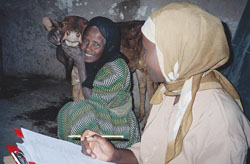Collecting epidemiological data and taking appropriate actions
Alemitu was aware that she needed to add to the health data that she and the volunteers had collected from households in the community, so the next stage was to organise the remaining data collection. She obtained local records, reports and guidelines from the woreda Health Office and held discussions with her supervisor and the kebele's community leaders. This created a mix of qualitative and quantitative data.
Look at the list below. Which of these types of data are qualitative and which are quantitative?
- Health centre and Health Post attendance figures.
- Data collected during discussion with local healthworkers about the most common health problems in the community.
- Data collected during a focus group discussion with community leaders who were asked about the priority health issues.
- Data from questionnaires on the number of cases of particular health problems in the community.
Numerical data (e.g. health centre and Health Post attendance records, and numbers of cases of particular health problems) are quantitative data. Gathering the experience and opinions of local healthworkers and community leaders adds qualitative data. Note that data gathered from questionnaires can be either quantitative or qualitative – it just depends on the questions that have been asked. For example, asking how many children someone has is a quantitative question, while asking them about their health priorities is a qualitative question (Figure 16.4).

After analysing all of the data, Alemitu identified the major public health problems of her kebele as being:
- diarrhoeal diseases
- parasites of the intestine
- respiratory problems: mainly pneumonia, but also some cases of pulmonary tuberculosis (PTB)
- malnutrition, including vitamin deficiency
- malaria
- measles among unvaccinated children.
She found that malaria, measles, outbreaks of diarrhoeal diseases and respiratory problems were among the leading causes of illness and death among children under the age of five years.
Let's just consider again Alemitu's place in the community.
When Alemitu has collected all the community survey data, do you think that there is a possible risk that she would be biased in prioritising her actions to resolve health problems, simply because she is a well-known member of the community?
Alemitu needed to be sure that she remained professional and as objective as possible when she reviewed and analysed the data that she collected, and decided on appropriate actions; for example, she should not try to make a particular health problem a priority for action simply because it has affected her own family. In other words, she needed to be fair and act equitably at all times.
In addition to acting equitably, what other ethical principles did Alemitu need to observe in the health services she provides? What other things did she need to bear in mind in her actions in the community?
She needed to remember the principles of beneficence and nonmaleficence. This means working in a way that 'does good' for the entire community, and also ensuring that actions 'do no harm'.